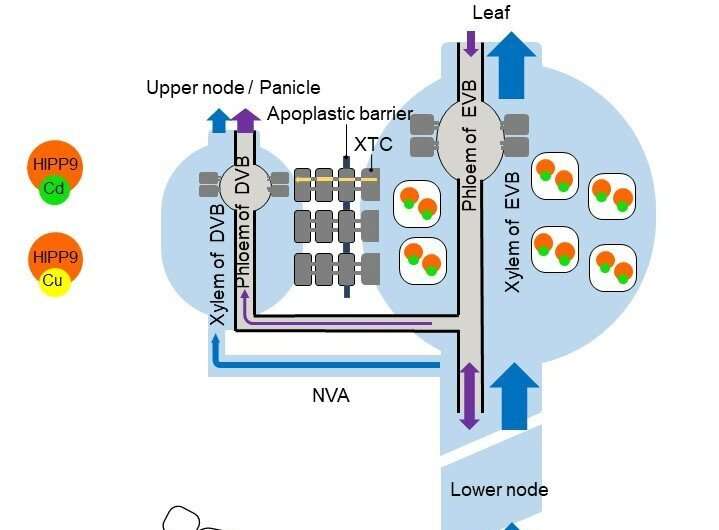| Researchers identify key gene controlling cadmium distribution between leaf and grain in rice | 您所在的位置:网站首页 › leafleaves › Researchers identify key gene controlling cadmium distribution between leaf and grain in rice |
Researchers identify key gene controlling cadmium distribution between leaf and grain in rice
 Schematic diagram showing the roles of OsHIPP9 in the retention of Cd and Cu in rice. Credit: IBCAS
Schematic diagram showing the roles of OsHIPP9 in the retention of Cd and Cu in rice. Credit: IBCAS
Cadmium (Cd), a toxic heavy metal contaminant of cultivated land, is harmful to humans through its accumulation in crops, especially rice. Therefore, strategies to limit Cd accumulation in rice grains are urgently needed. In rice, Cd is taken up from the soil by the roots and then transported to tissues aboveground. The nodes, which are vascular bundles connected to the roots, leaves and panicles, play an important role in the redirection of Cd in rice.
A research group led by Prof. Qu Leqing from the Institute of Botany of the Chinese Academy of Sciences (IBCAS) identified a Cd metallochaperone OsHIPP9 (heavy metal-associated isoprenylated plant protein 9) through a Cd tolerance yeast screening system and characterized its function in rice using genetic, cellular and biochemical strategies. The study has been published in Plant, Cell & Environment. OsHIPP9 shows binding capacity for Cd and copper (Cu), mainly dependent on the thiol in cysteines, to form a stable metal-protein complex. OsHIPP9 is mainly expressed in the xylem region of enlarged vascular bundles at nodes and root exodermis in rice. Knockout of OsHIPP9 increased the Cd concentrations of the upper nodes and panicles, but decreased Cd in expanded leaves, which possibly due to the changes in the distribution of Cd in the nodes. In addition, knockout of OsHIPP9 decreased the Cu concentration in aboveground tissues in rice, whereas overexpression of OsHIPP9 increased the Cu concentration in rice plants. These findings revealed the dual metallochaperone roles of OsHIPP9, chelating Cd in the xylem region of EVB for Cd retention in the nodes and chelating Cu in rice roots to aid Cu uptake, providing useful information for regulating Cd and Cu levels in rice grains. "OsHIPP9 may mediate more Cd migration into the leaves rather than into the grain, which is crucial for reducing Cd levels in the grain," said Dr. Xiong Shuo, first author of the study. More information: Shuo Xiong et al, Metallochaperone OsHIPP9 is involved in the retention of cadmium and copper in rice, Plant, Cell & Environment (2023). DOI: 10.1111/pce.14576 Provided by Chinese Academy of Sciences Citation: Researchers identify key gene controlling cadmium distribution between leaf and grain in rice (2023, March 13) retrieved 13 March 2023 from https://phys.org/news/2023-03-key-gene-cadmium-leaf-grain.html This document is subject to copyright. Apart from any fair dealing for the purpose of private study or research, no part may be reproduced without the written permission. The content is provided for information purposes only. |
【本文地址】